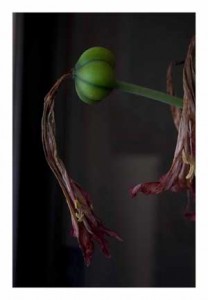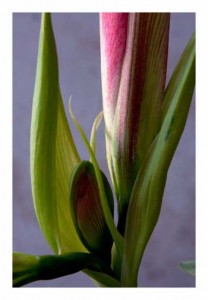
Nancy Macko
Remembering Vermeer I, 2009 – 2012
Digital Print
39 x 27 in.
Scripps College. Purchase made possible by the Jean and Arthur Ames Fund.

Nancy Macko
Tendrils, 2009 – 2012
Digital Print
39 x 27 in.
Scripps College. Purchase made possible by the Jean and Arthur Ames Fund.
Tendrils and Remembering Vermeer, like the other images in Nancy Macko’s Intimate Spaces suite, explore and redefine the way our society perceives aging. These images are partly inspired from Macko’s experiences in coping with her aging mother’s dementia. While watching her mother’s slow decline, Macko came to a new understanding of the life cycle as a continuous process, rather than a series of discrete stages.[1] Macko’s work encourages the viewer to join in this realization—to stop looking at childhood, youth, adulthood, and old age as separate phases, and to instead see the beautiful and surprising ways life’s phases overlap. The gradients in the life-cycle—the ways that a withering flower can simultaneously be delicate and sensual—are what Nancy Macko documents in these intimate photographs.
Tendrils, a softly lit, voluptuous portrait of a flower just opening, captures the flower’s fleshy translucency. Dynamic veins of color highlight the flower’s contours, making this seemingly restful image pulse with life. This is an image of triumphant youth, but such youth is fleeting. In Remembering Vermeer, we see the blossoming flower from Tendrils, transformed by time. The succulent petals no longer stretch towards the sun, but hang down withered, so dry that a single touch might reduce them to dust. Remembering Vermeer, however, is just as sensual an image as its counterpart. Indeed, the image highlights the delicate beauty of the dried flowers: the fluidity of their curves, and the muted rosy hues of their flesh. Additionally, these withered blooms hang alongside a wonderfully plump green seedpod, making this an image that, in the artist’s words, “depicts the beginning and the end at the same time.”[2] Old age, not bereft of its own kind of sensuality, exists alongside extreme youth. The allusion to Vermeer in the title refers partly to the photograph’s soft light and the dark background, but largely to the composition: the streaming shape of the shriveled blooms and round pod is reminiscent of the head-wrap in Vermeer’s Girl with a Pearl Earring.[3] That Vermeer’s painting of a beautiful young woman should be referenced in this image of dying flowers and seeds brings yet another part of the life cycle to this photograph, making it in an the simultaneity, of childhood, youth and old age.
Tara Contractor ’13

